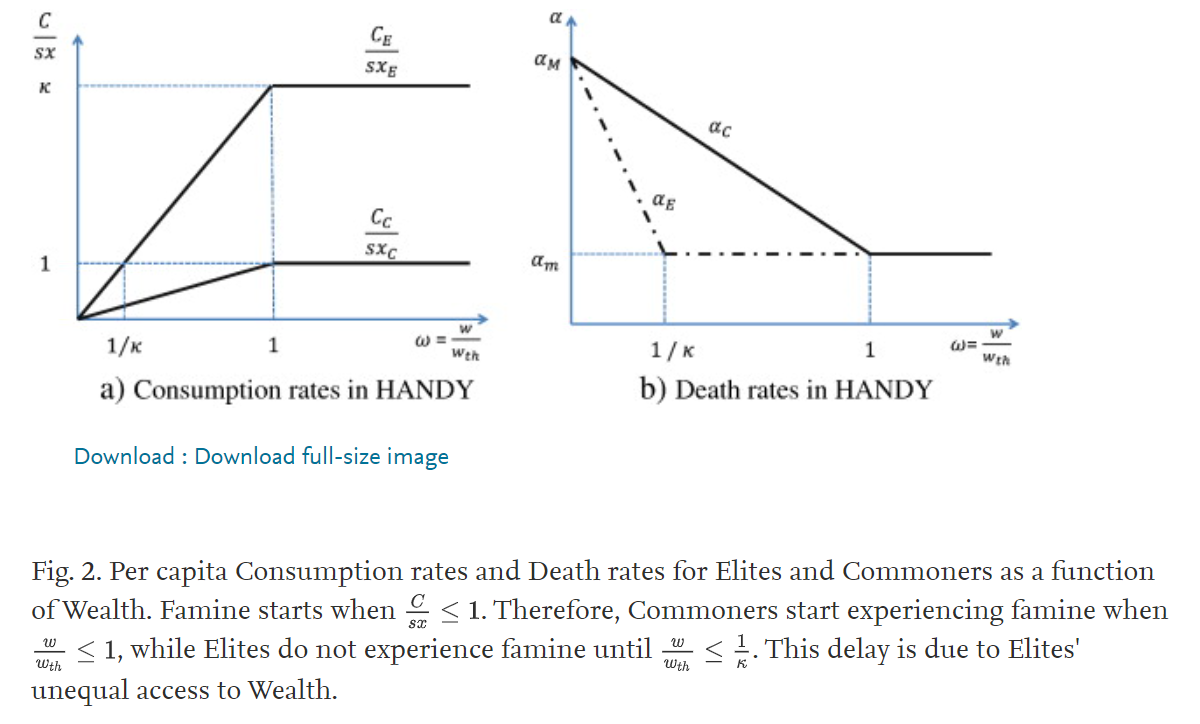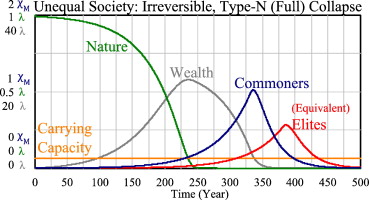Quoted from: Motesharrei, S. , Rivas, J. , & Kalnay, E. . (2014). Human and nature dynamics (handy): modeling inequality and use of resources in the collapse or sustainability of societies. Ecological Economics, 101(may), 90-102. https://doi.org/10.1016/j.ecolecon.2014.02.014
Human And Nature DYnamics (HANDY) was originally built based on the predator–prey model. We can think of the human population as the “predator”, while nature (the natural resources of the surrounding environment) can be taken as the “prey”, depleted by humans. In animal models, carrying capacity is an upper ceiling on long-term population. When the population surpasses the carrying capacity, mechanisms such as starvation or migration bring the population back down. However, in the context of human societies, the population does not necessarily begin to decline upon passing the threshold of carrying capacity, because, unlike animals, humans can accumulate large surpluses (i.e., wealth) and then draw down those resources when production can no longer meet the needs of consumption. This introduces a different kind of delay that allows for much more complex dynamics, fundamentally altering the behavior and output of the model. Thus, our model adds the element of accumulated surplus not required in animal models, but which we feel is necessary for human models. We call this accumulated surplus “wealth”.
Empirically, however, this accumulated surplus is not evenly distributed throughout society, but rather has been controlled by an elite. The mass of the population, while producing the wealth, is only allocated a small portion of it by elites, usually at or just above subsistence levels. Based on this, and on the historical cases discussed in the introduction, we separated the population into “Elites” and “Commoners”, and introduced a variable for accumulated wealth. For an analysis of this two-class structure of modern society, see Drăgulescu and Yakovenko (2001) and Banerjee and Yakovenko (2010). This adds a different dimension of predation whereby Elites “prey” on the production of wealth by Commoners. As a result, HANDY consists of four prediction equations: two for the two classes of population, Elites and Commoners, denoted by xE and xC, respectively; one for the natural resources or Nature, y; and one for the accumulated Wealth, w, referred to hereafter as “Wealth”. This minimal set of four equations seems to capture essential features of the human–nature interaction and is capable of producing major potential scenarios of collapse or transition to steady state.
A similar model of population and renewable resource dynamics based on the predator–prey model was developed in the pioneering work of Brander and Taylor (1998) demonstrating that reasonable parameter values can produce cyclical “feast and famine” patterns of population and resources. Their model showed that a system with a slow-growing resource base will exhibit overshooting and collapse, whereas a more rapidly growing resource base will produce an adjustment of population and resources toward equilibrium values. They then applied this model to the historical case of Easter Island, finding that the model provides a plausible explanation of the population dynamics known about Easter Island from the archeological and scientific record. They thus argue that the Polynesian cases where population did collapse were due to smaller maximum resource bases (which they call “carrying capacity”) that grew more slowly, whereas those cases which did not experience such a collapse were due to having a larger resource base (i.e., a larger carrying capacity). They then speculate that their model might be consistent with other historical cases of collapse, such as the ancient Mesopotamian and Maya civilizations or modern Rwanda.
However, the BT approach only models Population and Nature and does not include a central component of these historical cases: economic stratification and the accumulation of wealth. Thus, despite clear evidence for a stratified class structure in Easter Island's history prior to the collapse (as well as for Mesopotamia, the ancient Maya, and modern Rwanda), the BT model does not include class stratification as a factor. In their model, society produces and consumes as a single homogeneous unit. We feel that a historically realistic modeling of the evolution of human–nature dynamics in these stratified complex societies cannot be achieved without including this class stratification in the model. Brander and Taylor recognize that their model is simple, and that application to more complex scenarios may require further development of the structure of the model. We have found that including economic stratification, in the form of the introduction of Elites and Commoners, as well as accumulated Wealth, results in a much richer variety of solutions, which may have a wider application across different types of societies. HANDY's structure also allows for “irreversible” collapses, without the need to introduce an explicit critical depensation mechanism into the model as other models need to do. Thus while the Brander–Taylor model has only two equations, HANDY has four equations to predict the evolution of the rich and poor populations (Elites and Commoners), Nature, and accumulated Wealth (we examine other differences in Section 6.4 of the paper) The HANDY equations are given by:

It is to be noted that αC, αE, CC, and CE are all functions of w, xC, and xE. See Eqs. (4), (6) and Fig. 2a and b.











